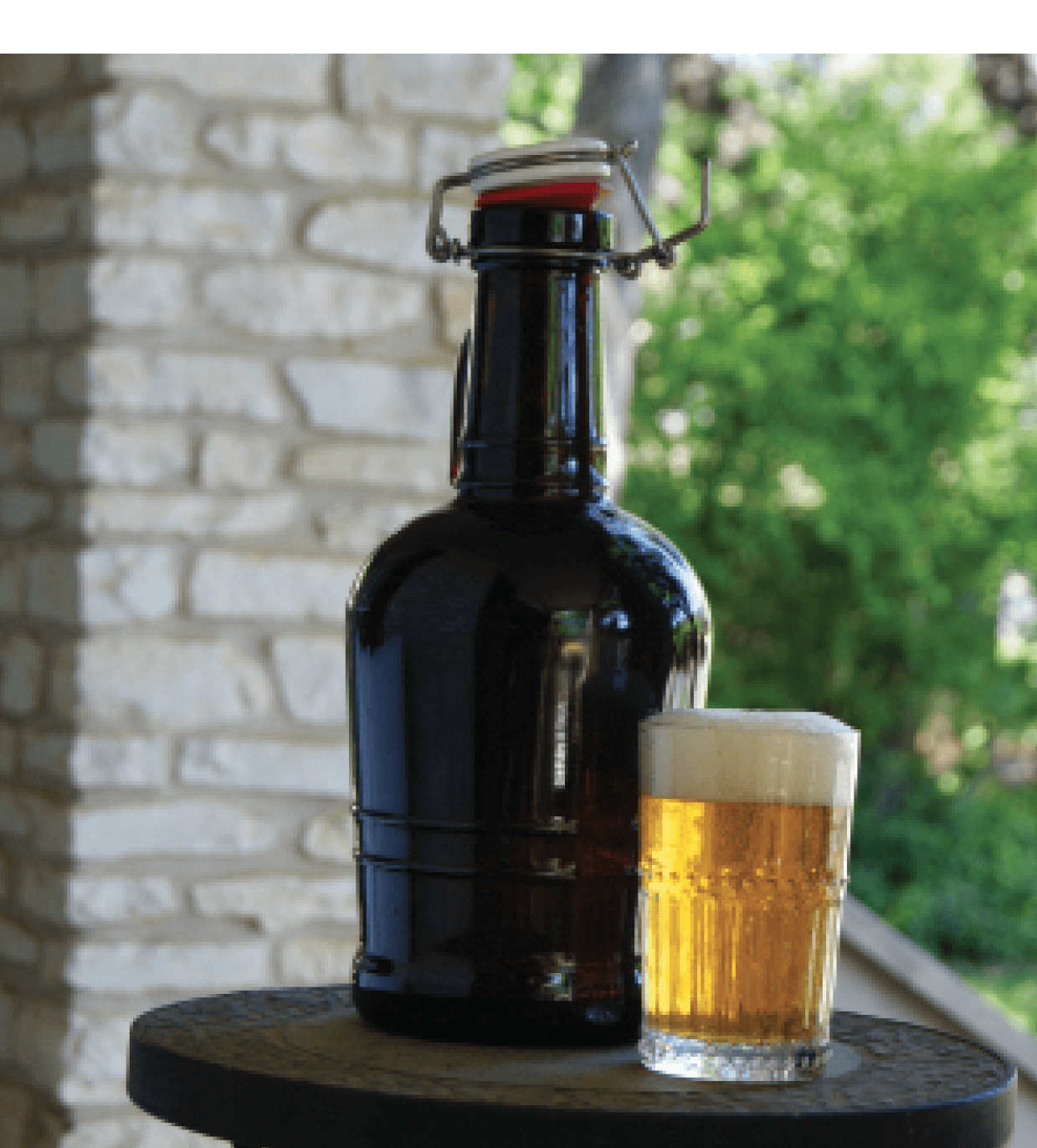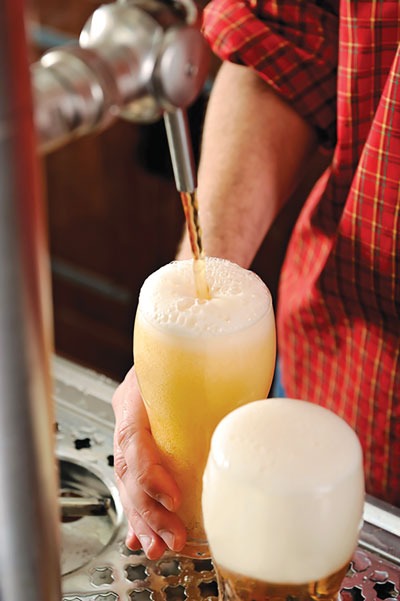Choosing & Using Growlers

With the increasing amount of draft-only beers created by breweries and local brewpubs, growlers are becoming required gear for craft beer drinkers. For the homebrewer that faces the decision of whether to bottle or keg, a growler can make the choice to keg more desirable. Most homebrewers bottle their beer because it is easier to share, but what if you want to keg your homebrew, how else are you going to share your new favorite beer with your fellow homebrewers, friends, and family? It’s growler time.
A Little Growler History
The need for transporting fresh beer goes back all the way to the late 1800s. Beer lovers would carry home beer from their local tavern in an open pail or hire a “bucket boy” to deliver the beer to their home. Could you imagine that? The practice was outlawed in many cities with the help of pre-Prohibition supporters, as young children were often sent out to pick up pails of beer for their fathers.
Fast forward quite a few decades, outlast Prohibition, and growler buckets had lids. It is said the term “growler” comes from the sound the escaping CO2 made when the lid was removed from the bucket.
Around the 1950s, instead of using pails, to-go beer containers were made of wax lined paper. Ideal? Hardly. It took about thirty more years until the modern day growler was introduced. I use the term “modern day” loosely, as it seems that over the past few years, growler styles have become the newest trend in personalizing the craft beer experience. Here we will explore all the options.
GROWLER STYLES
Traditional Growler
A 64-ounce (1.9-L) glass container with a narrow neck opening and screw top cap. Available at nearly every taproom or brewery, these usually come printed with the establishment’s logo and are relatively inexpensive ($5-8 unfilled). Sometimes the glass is brown, to prevent sunlight from skunking the beer; other times they are clear. A downside to these containers is that once they are opened, the carbonation of the beer quickly dissipates. If you know that you are going to be drinking a half-gallon of beer within 48 hours, not too daunting of a feat, then these growlers are probably the cheapest and easiest way to go.
Belgian Growler
A one- to two-liter (33- to 68-fl. oz.) glass container with a swing top and usually with an ornate metal handle. These containers have a heavier grade glass and the hardware on them makes them quite a bit more expensive ($30-60 depending on artwork, unfilled). I have a couple of swing tops that just have a screen-printed logo from the brewery. But, I have also seen some intricately etched glass collection worthy ones too. As with everything in life: The fancier, the pricier. While cost might be a deterrent, an advantage of this type of growler is the airtight seal the swing top closure creates. Again though, once opened it is best to enjoy the contents within a few days.
Growlette
Also called squeaker or squealer. A 32-ounce (0.9-L) glass container that reminds me of an old elixir bottle. I am starting to see more and more of these out and about. Drinkers are more willing to get a few pints to go in lieu of an entire half gallon. It has a narrower opening than a growler, so it’s easier to drink right out of the container. Usually printed with the tavern or brewery’s logo, growlettes are an even more inexpensive way ($3-5 unfilled) to walk away with a reusable souvenir full of brew.
Growler Pouch
A flexible growler that blocks light and oxygen. The pouches are environmentally friendly and are re-useable. They take up less space and are a great alternative to glass and cans. Not the prettiest to look at, but very functional and easy on the wallet (around $3–5 each).
Insulated Growler: A stainless steel container that is vacuum insulated and uses BPA free plastic. Originally used for keeping cold water cold (up to 24 hours) and hot coffee hot (up to 12 hours), it wasn’t too long after they came on the market that we started seeing these outdoorsy beer containers in breweries. The price, ranging from $50-70 depending on size, might seem a bit steep. However, it quickly becomes apparent that having a container that not only keeps a vacuum tight seal, but also keeps the beverage cold, is a necessity. In addition, the fact that light can’t sneak in and skunk your brew is a huge plus. While the previous growler types do mostly have amber tinted glass to decrease beer being light struck, it can still happen. A bit pricey, but these durable multipurpose vessels seem to be worth it.
The Crowler
The newest kid on the block is the can-growler aka: “crowler.” These 32-oz. (0.9-L) oversized beer cans are filled from filling machines that lots of brewpubs and growler fill shops now have in place. To fill it, a tube is placed from the beer faucet to the bottom and the vessel is filled with CO2. After purging, the empty crowler is then filled with beer and quickly sealed for freshness. The Crowler is 100% recyclable, protects beer from harmful light, won’t shatter if dropped, and is crushable. Typically the cost is included with the price of the crowler, but the cans themselves cost your brewpub or beer shop around $1 or so each.
Ceramic Growler
A cool trend based on the old artisan craft of pottery. I have seen a few old school ceramic growlers at flea markets and art shows. A company in Oregon established in 2010, Portland Growler Company, found a niche making this style of growler in the middle of Brewvana. They have encompassed the feeling of local by bringing Northwest native designers, ceramicists, and clay together to make these small batched creations. Prices are based on style and design, hovering right around $69. Much like the insulated growlers, these containers don’t allow light to get in. The swing top lid also keeps the carbonation sealed in for days. Functional growler meets local art
Stainless Steel Growler
A shiny container in a variety of sizes and styles, which uses food-grade stainless steel that has been either pickled or passivated in order to prevent your beer from tasting metallic. Single or double wall insulated, this type of growler also has the potential to keep your beer nice and cold. They come with screw tops, lined with food grade BPA-free plastic-lined lids, or hinge tops, with prices ranging anywhere from $20-70 unfilled. The variety in styles, shapes, and volume allow for taprooms to cater to the beer drinkers need. Much like the insulated growlers and the ceramic growler, light is unable to penetrate through the vessel so your beer stays fresh. It also seems like these would be a very more durable container compared to glass growlers, as long as you don’t mind the dents that would occur when you dropped it on the ground a few times.
The main safety concerns for handling growlers are pressure and heat. You do not want to over pressurize glass growlers or they can explode in shifting temperatures.
GROWLER SAFETY
Regulate the Temperature
After you fill a growler, try to keep it as close to the dispensed temperature as possible. If you are filling it a bar or brewpub, bring a cooler and keep it chilled.
Watch the Fill Level
Try to not overfill growlers. You need to leave enough headspace for a small amount of foam. An inch or two is all you need.
Pressurized Growler
One of the newest innovations to the growler market are models that are pressurized. These come in a variety of sizes and styles — from modern to more steampunk-esque, with features such as their own taps and mini gas regulators to control the CO2 pressure. These units are the priciest of all, however the ability to keep your beer under gas goes a long way toward keeping an already poured growler’s beer fresh and drinkable for much longer than a regular screw-top or swing-top growler. Depending on their setup, they range in price from around $100 for a conversion setup, to over $200 for larger or higher end units.
PROPER TECHNIQUES FOR FILLING GROWLERS
Most homebrewers love to share their beer. It is not always desirable to take an entire keg to a party, though. If you are interested in bringing SOME, but not ALL of your home brew to a party, filling a growler from your kegerator may be the perfect solution. You must exercise care when filling your growler so that you do not over pressurize it or you’ll have problems with your homebrew foaming over. Also, insulating growler coozies and ice blankets are available to help ensure that your beer-filled growler stays cold and crisp during transit. Overall, filling a growler from your home keg dispensing system is a very useful technique.
For homebrewers, I’m sure this situation is familiar: You bring a keg of homebrew over to a friend’s house, and everyone wants to try it. It doesn’t take long before your keg is sucking CO2. Especially for a specialty ale or high potency barleywine style ale, it is nice to make it last for a couple of weeks at least.
Homebrewers love to share homebrew when they have it, but once the keg is tapped, most have a hard time not sharing all of it. Though we’ve seen it many times, it’s always a big surprise how quickly five gallons can go “down the drain” among friends. By utilizing a growler instead of a full keg for parties, homebrew can go a lot further. Carrying a growler full of beer into a party is a lot easier than toting a 5 gallon keg, CO2 canister, ice, bucket, and all the rest of your gear into the scene.
Bottom Fill Technique
To avoid foam, one should attach a length of 1⁄2-inch food grade nylon tubing, or “beer line,” to the spigot on your kegerator’s tap (see image at right). This length of tubing should be long enough to reach just above the bottom of the growler that you are filling with beer. Half an inch is a good amount of room to leave. This is called the bottom fill technique. Next, turn your CO2 pressure down to about 2-4 PSI. This will help eliminate excess foam from CO2 pressure. Now, pour some beer out of the beer dispenser and beer line into a glass until the foam runs out and then transfer the beer line to the open growler. If the growler is chilled, it will help reduce foam as well.
Counter-Pressure Filling
This method requires a larger equipment investment on the front end, but the system purges the growler of oxygen and then slowly transfers beer into your growler with minimal loss of CO2. Systems like the WilliamsWarn Counter Pressure Filling Station can accommodate growlers up to 5.9 inches in diameter.
Top Fill Technique
If you don’t have the extra beer line lying around, you can always top fill it, but you might run into foam problems. To reduce the foam potential of a top fill, make sure to tip your growler, so that the beer stream hits the side of the growler at an angle. You should also do the following for a top fill:
- Reduce CO2 to 2 PSI
- Chill the growler prior to filling
- Apply an ice blanket or growler coozy to the growler
Keep in mind, too, that many states have laws that affect your ability to bring a growler to your local brewery and have it filled. Call ahead before you set out to the brewery to see what their policies are.
GROWLER CLEANING, MAINTENANCE, STORAGE
Keeping a growler clean is absolutely important. This should not be anything new for a homebrewer that uses brewery wash and sanitizers during their brew day. If the growler is dirty, then the beer going in it will be affected. Here’s how to keep your growler happy.
Rinse
Once you have polished off the last of the beer, rinse with hot water. If you do this quickly after it’s emptied, you won’t have to do much more.
Clean
Simply rinsing with hot water upon finishing the growler and properly drying upside down for 1-3 days makes quick work of the cleanup. If the growler has been sitting dirty from the last round, you are going to need to use some type of cleaner. Craft Meister makes a product called Growler Cleaning Tablets that are very convenient. Just fill the growler with warm water, add a tablet, soak for 10-15 minutes, then dump and rinse. You can also just use any alkaline cleaner, like PBW, to soak the growler. If the soil is heavy, use a bottle brush; growler specific cleaners, brushes and dryers are available from many beer related stores and homebrew shops..
Sanitize
As you would do with your other brewing equipment, after you clean your growler, it’s not a bad idea to hit it with your favorite sanitizer every now and then before you dry and store it. This is especially important if you’re not fastidious in your use, and sometimes leave residue in the growler at room temperature for a few days or weeks after you’ve emptied them.
Dry
Flip the growler over, lean it safely against something, rest it in an appropriately-sized carboy drainer, or Growler Collar, and let it drip dry. Let the air do the drying and you will be left with a clean surface ready to fill with new beer.
Store
Once your growler is clean, and if you don’t think you’re going to use it again for a while, be sure to store it carefully as you would for any other brewing equipment. Find a cool, dry spot where they can’t collect moisture or mold. If you have glass growlers, be sure to place them in storage where they will not be knocked around against each other as they can crack and shatter. Also, as mentioned above, resist the urge to store your growlers without cleaning after you use them!
GROWLER ACCESSORIES
The evolution of the beer growler is in full swing. It’s not just the actual vessels that have seen all the attention, but their accessories as well.
Growler coozies are very useful for not only insulating your glass growler, but also for protecting the growler from accidental bumps that could possibly shatter your party contribution. If your local brewpub sells growlers of beer, they will most likely have coozies for sale with their logo printed on them. You can also find such coozies online or have some printed up with your own homebrewery name or logo.
Aside from the coozie, there are plenty of other growler holders, from holders specifically for car travel, bike travel, or ice jackets. Keeping your growler safe and cold for the duration of the trip is the ultimate goal here. No need to bring a whole cooler when an appropriate holder will do.
If your homebrew is on draft at your house, then hopefully you have devised a growler filling system. There are many ways to accomplish this, from a simple ½-inch silicone tube fitted over your faucet, to more elaborate counter-pressure fillers. See page 55 for more on filling your growler. One piece of equipment that makes filling growlers easy and less of a mess is an internal steel fitting attached to a length of tube. The steel fitting is simply inserted in the faucet and you open the tap to start filling the growler. These steel fittings are faucet specific, so be sure to get the fitting that is specific to your faucet type.
Growler closures have also come a long way. The swing top growlers are great for longer term storage of your beer, but newer versions of the screw caps are also seeing less ‘bleed’ of CO2. Paying a little extra for a good closure maybe well worth the cost if you are not planning on drinking a growler fresh.
Finally the new accessories coming out from growler companies with their own miniaturized draft components is basically changing what we think about growlers. Now beer lovers don’t need to drink within a day or two after the growler starts getting poured. These are great for vacations, family visits or if you just want to pull off a gallon or liter of beer to try.






